Testing a wifi link based on Ubiquiti NanoStation M2 equipment
There was a need to test in detail a pair of NanoStation M2 for the possibility of using them to organize a link for 5 km.

Since this is not our first testing and the scheme has already been tested for performance in the first test last summer, I will not describe the methodology in detail.
The points are located in close proximity, the signal level is remarkable:
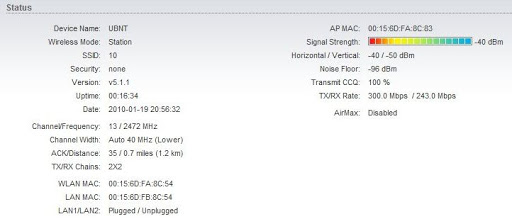
One feels the presence of the MIMO mode in the equipment, the speed has pleased

The failure rate was formed when the friend was between the two antennas.
The average speed of the simplex channel was 42 Mbit / s (left).
In duplex mode, the points gave 26 Mbit / s in each direction and 52 Mbit / s in total (right).
10 pings 1024, 16384 and 65000 bytes in length were also sent, the results are as follows:
1024 - Minimum = 1 ms, Maximum = 2 ms, Medium = 1 ms
16384 - Minimum = 8 ms, Maximum = 11 ms, Medium = 8 ms
65000 - Minimum = 19 ms, Maximum = 28 ms, Medium = 22 ms
')
When the output signal level was maximized (28 dBm), -61 dBm was received at the receiver side
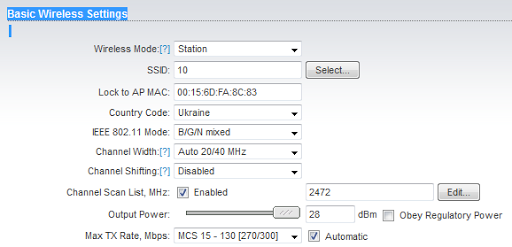
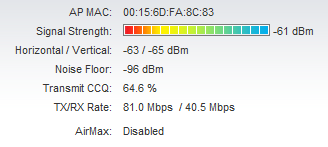
According to the test results, the situation is as follows:

In simplex mode, the average speed of 12.7 Mbit / s is in duplex 5.25 per transmission and 6.37 per reception.
A test was also conducted when transmitting real-time IPTV traffic (RTP). The intensity of the generated stream is 10 Mbps. The results are as follows:

One-way delay: the minimum value is 2 ms, the average is 12 ms, and the maximum is 85 ms.
Jitter delay: 4 to 33 ms.
Lost Packages - 0.092%
Quite acceptable values, but when transmitting a stream with a higher intensity, the situation would have deteriorated significantly, as throughput measurements showed that the speed of the channel is 12.7 Mbit / s
We had certain hopes for the third test, the signal level was quite good.
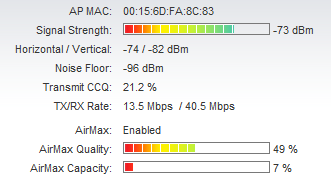
But the test results somehow did not please ...

The capacity of the duplex channel is only 1.5 Mbit / s in each direction.
When transmitting an RTP stream with an intensity of 1451 kbps, the loss was 0.3%
Jitter varied from 12 to 300 ms
With a stream of 3 Mbps. the situation is even worse, losses from 1% to 2.3%, jitter from 32 to 110 ms
According to the ping, the situation is as follows:
1024 - Minimum = 4 ms, Maximum = 12 ms, Medium = 6 ms
16384 - Minimum = 46msec, Maximum = 205 ms, Medium = 77 ms
65000 - Minimum = 181 ms, Maximum = 319 ms, Average = 243 ms (one lost)
Given the parameters of the output power, the sensitivity of the receiver and the antenna gain from the datasheet to the access point, the expected signal level at the receiving point was calculated:

The calculation error was 4 dB, which is quite acceptable for such a distance.
Expected coverage area

According to the test results, the equipment did not justify the hopes placed on it, unfortunately, we didn’t have time to play with the settings at the farthest point, because they didn’t take charge of the second laptop and it died safely ... But the default settings obviously do not satisfy and our requirements for this equipment.
To be continued ...
Course to the 2nd point (1.37 km.)
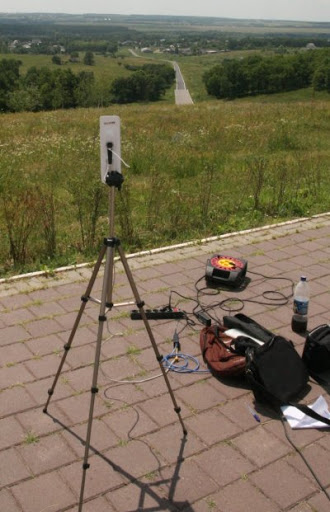
Course to the 3rd point (5.54 km)
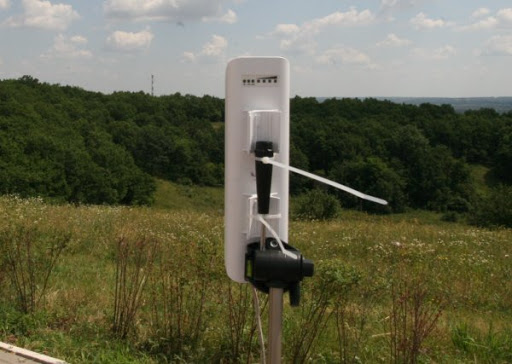
Installation point of the first point


Since this is not our first testing and the scheme has already been tested for performance in the first test last summer, I will not describe the methodology in detail.
Test number 1. The distance between the points is 10 meters.
The points are located in close proximity, the signal level is remarkable:

One feels the presence of the MIMO mode in the equipment, the speed has pleased

The failure rate was formed when the friend was between the two antennas.
The average speed of the simplex channel was 42 Mbit / s (left).
In duplex mode, the points gave 26 Mbit / s in each direction and 52 Mbit / s in total (right).
10 pings 1024, 16384 and 65000 bytes in length were also sent, the results are as follows:
1024 - Minimum = 1 ms, Maximum = 2 ms, Medium = 1 ms
16384 - Minimum = 8 ms, Maximum = 11 ms, Medium = 8 ms
65000 - Minimum = 19 ms, Maximum = 28 ms, Medium = 22 ms
')
Test number 2. The distance between points - 1.34 km
When the output signal level was maximized (28 dBm), -61 dBm was received at the receiver side


According to the test results, the situation is as follows:

In simplex mode, the average speed of 12.7 Mbit / s is in duplex 5.25 per transmission and 6.37 per reception.
A test was also conducted when transmitting real-time IPTV traffic (RTP). The intensity of the generated stream is 10 Mbps. The results are as follows:

One-way delay: the minimum value is 2 ms, the average is 12 ms, and the maximum is 85 ms.
Jitter delay: 4 to 33 ms.
Lost Packages - 0.092%
Quite acceptable values, but when transmitting a stream with a higher intensity, the situation would have deteriorated significantly, as throughput measurements showed that the speed of the channel is 12.7 Mbit / s
Test number 3. The distance between the points is 5.54 km.
We had certain hopes for the third test, the signal level was quite good.

But the test results somehow did not please ...

The capacity of the duplex channel is only 1.5 Mbit / s in each direction.
When transmitting an RTP stream with an intensity of 1451 kbps, the loss was 0.3%
Jitter varied from 12 to 300 ms
With a stream of 3 Mbps. the situation is even worse, losses from 1% to 2.3%, jitter from 32 to 110 ms
According to the ping, the situation is as follows:
1024 - Minimum = 4 ms, Maximum = 12 ms, Medium = 6 ms
16384 - Minimum = 46msec, Maximum = 205 ms, Medium = 77 ms
65000 - Minimum = 181 ms, Maximum = 319 ms, Average = 243 ms (one lost)
Theoretical calculations
Given the parameters of the output power, the sensitivity of the receiver and the antenna gain from the datasheet to the access point, the expected signal level at the receiving point was calculated:

The calculation error was 4 dB, which is quite acceptable for such a distance.
Expected coverage area

Results
According to the test results, the equipment did not justify the hopes placed on it, unfortunately, we didn’t have time to play with the settings at the farthest point, because they didn’t take charge of the second laptop and it died safely ... But the default settings obviously do not satisfy and our requirements for this equipment.
To be continued ...
A small photo report
Course to the 2nd point (1.37 km.)

Course to the 3rd point (5.54 km)

Installation point of the first point

Source: https://habr.com/ru/post/98633/
All Articles